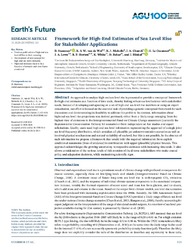Framework for High-End Estimates of Sea Level Rise for Stakeholder Applications
van de Wal, R. S. W.
Nicholls, R. J.
Lowe, J. A.
Horton, B. P.
White, K.
Behar, D.
DOI: https://doi.org/10.1029/2019EF001163
Persistent URL: http://resolver.sub.uni-goettingen.de/purl?gldocs-11858/9461
Persistent URL: http://resolver.sub.uni-goettingen.de/purl?gldocs-11858/9461
Stammer, D.; van de Wal, R. S. W.; Nicholls, R. J.; Church, J. A.; Le Cozannet, G.; Lowe, J. A.; Horton, B. P.; White, K.; Behar, D.; Hinkel, J., 2019: Framework for High-End Estimates of Sea Level Rise for Stakeholder Applications. In: Earth's Future, Band 7, 8: 923 - 938, DOI: 10.1029/2019EF001163.
 |
Dokument öffnen: |
An approach to analyze high-end sea level rise is presented to provide a conceptual framework for high-end estimates as a function of time scale, thereby linking robust sea level science with stakeholder needs. Instead of developing and agreeing on a set of high-end sea level rise numbers or using an expert consultation, our effort is focused on the essential task of providing a generic conceptual framework for such discussions and demonstrating its feasibility to address this problem. In contrast, information about high-end sea level rise projections was derived previously either from a likely range emerging from the highest view of emissions in the Intergovernmental Panel on Climate Change assessment (currently the Representative Concentration Pathway 8.5 scenario) or from independent ad hoc studies and expert solicitations. Ideally, users need high-end sea level information representing the upper tail of a single joint sea level frequency distribution, which considers all plausible yet unknown emission scenarios as well as involved physical mechanisms and natural variability of sea level, but this is not possible. In the absence of such information we propose a framework that would infer the required information from explicit conditional statements (lines of evidence) in combination with upper (plausible) physical bounds. This approach acknowledges the growing uncertainty in respective estimates with increasing time scale. It also allows consideration of the various levels of risk aversion of the diverse stakeholders who make coastal policy and adaptation decisions, while maintaining scientific rigor.
Statistik:
ZugriffsstatistikSammlung:
- Geographie, Hydrologie [454]
This is an open access article under the terms of the Creative Commons Attribution-NonCommercial-NoDerivs License, which permits use and distribution in any medium, provided the original work is properly cited, the use is non-commercial and no modifications or adaptations are made.

